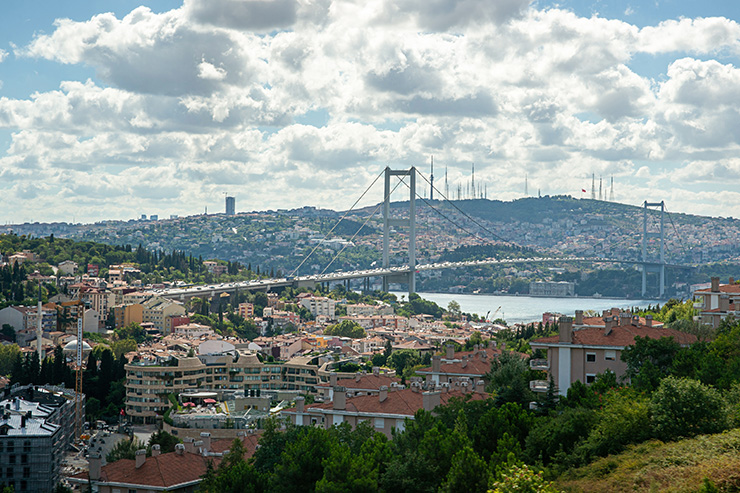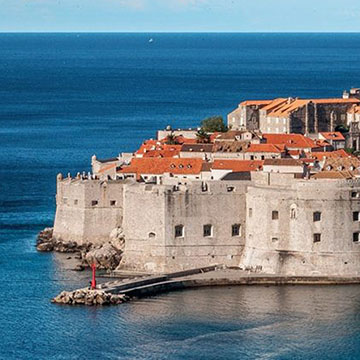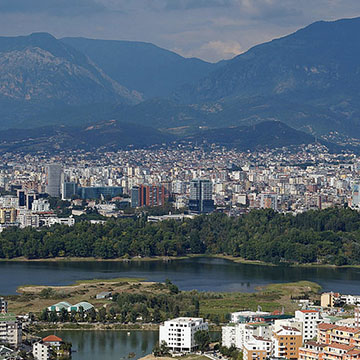
Türkiye
Turkey, officially known as the Republic of Turkey, has the majority of its territory in Anatolia, with a small part extending into Thrace, which is an extension of the Balkans. Surrounded by seas on three sides, Turkey is divided by the Istanbul Bosporus and the Dardanelles, forming two peninsulas. These straits separate Anatolia from Thrace, distinguishing Asia from Europe. Turkey has become a popular destination for foreign tourists with its long coastlines along the Mediterranean and its extension, the Aegean Sea.
Turkey has coastlines along four seas: the Aegean Sea, the Mediterranean Sea, the Black Sea, and the Sea of Marmara. The country boasts numerous natural beauties with diverse geographical and climatic features. Shaped under the influence of different cultures, Anatolian history has made Turkey exceptionally rich in cultural heritage.
If you want to explore the must-visit places in this beautiful country, you should definitely read our article on Places to Visit in Turkey.
Capital, Cities, and Regions of Turkey
The capital of Turkey is Ankara, located in the Central Anatolia region. Turkey is divided into seven geographical regions based on geographical and climatic features. The largest city, Istanbul, is situated in the Marmara Region. The Aegean and Mediterranean regions cover the western and southern coastal areas, respectively. The Black Sea region stretches along the northern axis of the country. The Inner Anatolia region is in the middle of Anatolia, and the Eastern Anatolia Region includes Lake Van and Mount Ararat in the east. The Southeast Anatolia Region is where the province of Mardin is located.
There are significant differences and diversity among the regions in terms of economic development, ethnic composition, and culture. The most important cities include Istanbul, Ankara, Izmir, Adana, Mugla, Antalya, Trabzon, Gaziantep, Bursa, Erzurum, Mardin, Eskisehir, and Diyarbakir.
Where is Turkey?
Turkey shares its borders with Bulgaria to the northwest, Greece to the west, Georgia to the northeast, Armenia, Iran, and the Nakhchivan exclave of Azerbaijan to the east, Iraq, and Syria to the southeast. The Mediterranean is to the south, the Aegean to the west, and the Black Sea to the north.
When to Visit Turkey?
Due to the unique geography that allows experiencing all four seasons simultaneously in different corners of the country, the ideal time to visit Turkey varies depending on the region. Winter sports destinations like Palandoken, Uludag, and Erciyes receive the best snow levels in January and February.
The Black Sea region is rainy for most of the year, making late spring and early autumn suitable for visits. The Aegean coast has a short season, especially in July and August, for beachgoers. However, Antalya, known as the "pearl of the Mediterranean," extends its tourism season for sea tourism from May to November. The southwestern point where the Aegean and the Mediterranean meet, including districts like Fethiye, Bodrum, and Datca in Muğla, is the most preferred destination by both domestic and foreign tourists.
Turkish Culture
Turkey exhibits significant differences between communities and classes based on ethnicity and income. These differences lead to substantial variations between social life in conservative Anatolian cities and social life in western regions, especially Istanbul, which is the cultural capital.
Turkish Cuisine
The Turkish cuisine, formed as a result of the interaction of different cultures during the Ottoman Empire, is one of the richest cuisines in the world. It shares many common dishes and characteristics with Greek, Arab, and Armenian cuisines. Eating habits vary across the country's regions. While olive oil vegetable dishes dominate in the western regions, grilled meat dishes stand out in the east. The Black Sea region has a unique type of fish, anchovy, which is abundant in the region and is used in various dishes. Different fish species are found in the Aegean, Mediterranean, and Marmara seas, playing a significant role in the coastal cuisine.
Areas like Southeast and West Anatolia, inland parts of the Black Sea Region, and Inner West Anatolia are places where small-scale animal husbandry is common. Dishes made from lamb and goat meat are widespread. In the Eastern Anatolia region, where large-scale animal husbandry is practiced, beef is commonly used in local dishes, along with poultry and game meats such as goose, quail, partridge, and rabbit.
Sweets are also a rich part of Turkish cuisine. Especially, Gaziantep baklava is world-famous. Milk desserts and desserts made by boiling fruits are also delicious. Fruits are also used in meat dishes in Ottoman cuisine. In major cities like Istanbul, Ankara, and Izmir, you can find options from world cuisine.
Souvenirs from Turkey
Undoubtedly, one of the most popular gifts you can take from Turkey is Turkish delight. Delights produced with the aroma of various fruits and nuts, such as mint, rose, and quince, are globally famous. Apart from this, Turkish coffee sets, which are an Ottoman tradition, and nargile (hookah) sets with their cooking methods and tools are also popular gifts.
Festivals in Turkey
National and religious holidays are celebrated with enthusiasm in Turkey. In addition to these, almost every province has numerous local festivals. Besides festivals promoting local agricultural products and flavors, film festivals are organized annually in Istanbul, Adana, and Antalya. The Antalya Golden Orange and Adana Golden Boll festivals are highly prestigious for the local film industry. The Istanbul Film Festival, organized by the Istanbul Foundation for Culture and Arts (IKSV), awards the prestigious Golden Tulip in an international context.
Every two years, the Istanbul Biennial and Istanbul Design Biennial, organized by IKSV, are significant international cultural events in the country. In Istanbul, two international contemporary art fairs are held every October and November. Additionally, the Istanbul Music Festival, organized by IKSV every June, holds the title of Turkey's oldest art event.
Holidays/Festivals/Special Days in Turkey
- New Year (January 1)
- Eid al-Adha
- Sugar Feast
- Labor and Solidarity Day (May 1)
- Atatürk Memorial, Youth and Sports Day (May 19)
- National Sovereignty and Children's Day (April 23)
- Victory Day (August 30)
- Republic Day (October 29)
Climate and Weather in Turkey
Three climate types dominate different regions in Turkey. The Mediterranean climate is prevalent on the western and southern coasts, the Black Sea climate on the Black Sea coasts, and the continental climate in the inner and mountainous eastern regions. The Black Sea climate is similar to the Oceanic climate, with warm and rainy summers and cold and snowy winters.
The continental climate, prevalent in the interior and eastern parts, results in hot and dry summers and cold winters with significant snowfall. The Mediterranean climate in the south has very hot and dry summers and mild and rainy winters. The climate in the northern and eastern parts of the Southeastern Anatolia Region is classified as a continental climate.
Short History of Turkey
The first settlements on the lands of Turkey were initiated by societies such as Aeolians, Dorians, Ionians, Thracians, and Persians during the Neolithic Age. Subsequently, the Hellenistic period occurred under the rule of Alexander the Great, followed by the Roman and Byzantine periods. The Turkishization movement began with the settlement of the Seljuks in Anatolia in the 11th century, and after the victory following the Battle of Malazgirt in 1071, Byzantine dominance in Anatolia weakened in favor of the Turks.
After the collapse of the Seljuks, various small Turkish principalities were formed in Anatolia until the Mongol invasion in 1243. After the invasion, many small Turkish beyliks were formed in Anatolia. The Ottomans, one of these beyliks, became dominant in Anatolia from the late 13th century onwards. In addition to Anatolia, they established a large empire with territories in Southeastern Europe, Western Asia, and North Africa, becoming a significant power in Eurasia and Africa. After the 17th century, the Ottoman Empire entered a period of decline.
After being defeated in World War I and collapsed, the Republic of Turkey was established by Mustafa Kemal Atatürk following the War of Independence in 1923.
Economy of Turkey
Turkey ranks 17th in the world in terms of gross domestic product. It is a founding member of the OECD and G-20 major economies. Turkey has a strong automotive industry and competes in shipbuilding with significant markets like Malta, Norway, the United Kingdom, and the Marshall Islands. Tuzla, Yalova, and Izmit are the main centers of the shipbuilding sector. Other important sectors of the Turkish economy include banking, construction, home appliances, electronics, textiles, oil refining, petrochemical products, food, mining, iron and steel, and machinery industry.
A quarter of the population works in the agricultural sector. Only 30% of the working population consists of women, the lowest rate among OECD countries. Some of the most recognized brands in Turkey on the international stage are Beko and Turkish Airlines.
Languages Spoken in Turkey
The official language of Turkey is Turkish, and the entire population is fluent in Turkish. Additionally, different languages, such as Lazca and Kurdish, are spoken regionally. The Georgian, Armenian, and Circassian populations in the country also speak these languages. The most common foreign language in the country is English.





